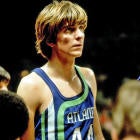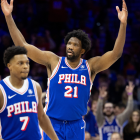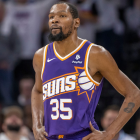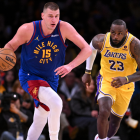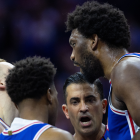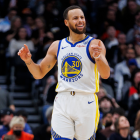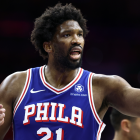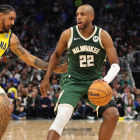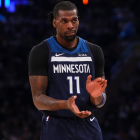This is the second of three parts exploring players from previous eras (prior to 2010) who would thrive in today's NBA. We covered forwards who would be much more effective earlier.
To paraphrase James Brown, this is a guard's world. The NBA is dominated by perimeter players. Gone are the days when sheer size and a decent drop step or hook shot made a player valuable -- provided he could foul hard enough. Almost all league's biggest names are wings and guards who have a 3-point shot. Even the most valued centers have some range (DeMarcus Cousins), can pass (Nikola Jokic) and/or play defense (Marc Gasol).
Many of today's superstars are guards, even if forwards like LeBron James, Kevin Durant and Kawhi Leonard rate among the league's best. Guards benefit from expanded use of the 3-pointer, the removal of hand-checking -- which engender more freedom than the game witnessed in past generations -- and advanced athleticism and skills training.
It made us wonder which guards from previous eras were under-appreciated or underutilized and would thrive today.
Anfernee 'Penny' Hardaway | PG
Teams: Magic, Suns, Knicks, Heat
Hardaway's an interesting, debatable choice. At 6-foot-7, his combination of athleticism and vision was unparalleled. Injuries derailed what was going to be a magnificent career; today's health prevention efforts may have legitimately extended and saved his NBA path.
The question with Hardaway is whether his shooting could get where it would need to. He was a career 31.6 percent shooter from deep. But what's interesting is at the end of his career, with the Heat, he shot 42 percent from beyond the arc, and in 2004 with Phoenix and New York he shot 38 percent. There's reason to think that if he'd been developed to adapt to modern style, he would have learned to bomb from range.
Hardaway in an up-tempo system is pretty frightening to think about and with his vision, he'd be a terror.
Dennis Scott | SG
Teams: Magic, Mavericks, Suns, Knicks, Wolves, Grizzlies
At 6-8, Scott may play up front in today's NBA, but he was a phenomenal shooter who was ahead of his time in 3-point rate. In 1996 he posted a 56.8 percent 3-point rate, which would have been among the top 20 playing at least 20 minutes per game last season. For 1996, that's Back To The Future Part II-type stuff.
You want range?
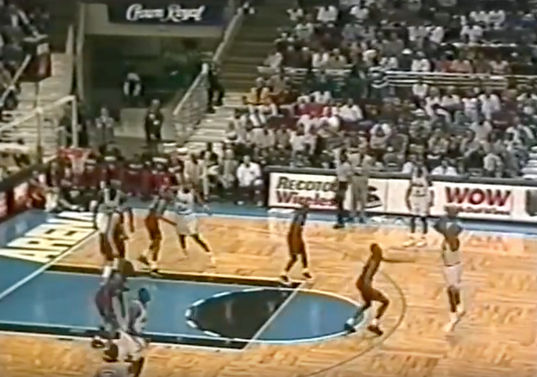
That's range (this shot would barely be a 3-pointer today, this game was played when the league moved the line closer for the 1994-95 through 1996-97 seasons.)
While not known as a great defender, his size could be valuable against some of the longer two-guards (Klay Thompson, Tony Snell, Khris Middleton) and as a willing passer, he'd fit well in a lot of systems. Slide Scott onto Memphis' roster today and the Grizzlies are considerably better. Put Scott on Brooklyn (ninth most made 3s per 100 possessions last season) and the Nets are considerably better. Scott was tremendous for the Magic, an underrated part of the Shaq-Penny era's success. He's custom-made for today's NBA.
Glen Rice | SG
Teams: Heat, Hornets, Lakers, Knicks, Rockets, Clippers
Rice was considered a small forward, but in today's game, there's a good chance he plays two-guard, or at least operates as such, even at 6-8.
He got buckets, which matters in any era.
Counter to that, one could argue that Rice's top three shooting seasons came in those three seasons where the NBA shortened the line. But given his 6-7 frame and how effortlessly he made them, he would adapt. He also would likely play shooting guard today, given his style. Also, check out the play at 4:50 in the video above, a modified runner, and imagine if Rice had learned and incorporated a Euro step.
Rice's ability to post up would not be as valuable, but he was also terrific in transition and coming off screens, which would be a bigger part of his game today.
Rice wasn't a good playmaker, but his scoring profile was a mix of Paul George and James Harden, and with the kind of space provided today, along with the way teams bomb from deep, Rice would be a critical piece for any team.
Gilbert Arenas | PG
Teams: Warriors, Wizards, Magic, Grizzlies
Before the sad end to his career -- including the bizarre gun incident in the Wizards locker room -- injury issues and controversial social media posts, Agent Zero was ahead of his time as a high-volume, efficient scoring guard.
At his peak, Arenas scored as effortlessly as any player:
Playing the point, Arenas was regarded as a gunner. But the standards and roles for point guards have shifted dramatically. Arenas wouldn't be asked to set the offense, he would be turned loose. With a faster pace and more usage, Arenas would be far less constrained than he was in the mid 2000s.
As an example, among guards Arenas does not have a single-season usage rate among the top 50 all time. In 2010-11 Derrick Rose had a higher usage rate (32.2 percent good for 50th) than Arenas' best (52nd, 31.9 percent in 2009-10). Isaiah Thomas and DeMar DeRozan were top 20 all-time among guards last season. A team built around Arenas likely has him in a much larger role. Considering his 2006 shooting numbers (45 percent overall and 37 percent from deep) -- before injuries took their toll -- his efficiency would translate.
Dan Majerle | SG
Teams: Suns, Cavaliers, Heat
Thunder Dan was one of the most prolific 3-point shooters before the 3-point shot was fashionable.
A two-time All-Defense selection who shot 36 percent from deep, Majerle would be a 3-and-D player today and would provide valuable spacing. His defense is an interesting consideration because his forte guarding with strength, but lateral mobility is a lot more important today.
Majerle was tough and physical, but would have been able to get around screens effectively? At worst, it seems he would grade as average today, and with that kind of shooting ability, he would thrive.
Rafer Alston | PG
Teams: Bucks, Raptors, Heat, Rockets, Magic, Nets
"Skip to My Lou" probably would be a backup today, but nonetheless valuable. His finishing ability was limited and he shot less than 45 percent on 2-point shots in all but one of his 11 seasons. He also had three seasons when he shot better than 37 percent from 3-point range, and four when he averaged double-digit assists per 100 possessions. Alston would still be a backup, but he'd be considerably more valuable and freed up in the pace-and-space game. There's a reason he played such a big role on the Magic's 2009 Finals run.
Alston wasn't a great defender, but got the job done, and there were seasons when he was a legitimate contributor on that end. With much less emphasis on size, and given how weaker defenders can be covered up with help today, there's every reason to think the 6-2 Alston would be more valued now than when he played (1999-2010).
Joe Dumars | SG
Team: Pistons
He shot 40 percent or better from 3-point range in seven of his 14 seasons and was integral to a team that defined defense. At 6-3, he was Gary Harris' size, but had a much larger frame that allowed him to bully opponents. Dumars also played at a glacial pace. That 1989 Pistons championship team was 25th in the league in pace, the 1990 repeat team was 26th. That's not to say that Dumars would have needed to play fast, but imagine him as the combo guard under Rick Carlisle in Dallas.
Mookie Blaylock | PG
Teams: Nets, Hawks, Warriors
Blaylock checks all the boxes for players who would be better today. He was small, barely 6-foot. But in today's game allows for smaller point guards. And considering how Blaylock defended and could shoot the 3, he'd start for a lot of teams.
With Blaylock it's not the percentage on 3s -- he topped out at 37 percent -- but the volume. He shot more than 5 per game in 1994-95 through 1996-97 and in 1999, and had five seasons shooting better than 35 percent from deep with that kind of volume. Throw in his ability to make tough finishes and Blaylock, whose post-playing days have been marred by a prison sentence for a car accident resulting in a fatality, would have been much more appreciated today.
Raja Bell | SG
Teams: 76ers, Mavericks, Jazz, Suns, Hornets, Warriors
Finding a member of the Seven Seconds or Less Suns among this group may seem weird because those teams -- by their nature -- set the pace-and-space path for the Warriors and even the Spurs.
But Bell was never given the real credit he deserved; his defense would be much more appreciated today (he was a two-time All-Defense selection). Add that to his 3-point shooting (40.6 percent over a 14-year career) and he would be highly sought in a 3-and-D role.
Bell would have thrived in modern defensive schemes that require versatility and basketball IQ, or at least he would be more recognized for his strengths in those areas.
Mahmoud Abdul-Rauf | PG
Abdul-Rauf's incredible handle and lightning-fast release would put him in elite company today. His ability to play on or off ball would be highly utilized, particularly with more hand-offs from bigs on the perimeter. Abdul-Rauf's averages in 1996, 19.2 points and 6.8 assists per game, signal he'd be ideal in a high-usage situation (his 1996 figure of 25.1 percent would not rank among the top 20 today). He also likely would find more support from the league regarding spiritual and political beliefs (he refused acknowledge the National Anthem before games) he feels shortened his career.
Mitch Richmond | G
Teams: Warriors, Kings, Wizards, Lakers
A career 38 percent 3-point shooter, who in 1996 averaged 9.6 3-point attempts per 100 possessions and knocked down 43.7 percent of them.
Already a Hall of Famer, his efficiency would be off the charts. He most likely would play off the ball more, but his shot volume may actually increase from his career number of 4.9 3-point attempts per 100 possessions.
Tim Hardaway | PG
Teams: Warriors, Heat, Mavericks, Nuggets, Pacers
Before the Golden Boy, Stephen Curry, there was Run TMC with Tim Hardaway.
Known mostly for his shooting, Hardaway averaged 8.2 assists for his career, and double-digits assists in two seasons (10.0 in 1991-92, 10.6 in 1992-93). And his 3-point volume (7.2 attempts per 100 possessions) would increase today.
And without hand-checking rules, Hardaway's game would be off the charts.
Pete Maravich | PG
He was the prototype for Steve Nash and Stephen Curry. Watch some of the off-the-dribble 3s above (the NBA only had the 3-point shot in his final season, when he went 10 of 15 from deep), and the boldness in passing and handle. At 6-5, he'd be ideal as a point guard today, and his vision would be revered. Often injury plagued, modern medicine would keep him on the floor today, and his obsession with the game is legendary. He would have made the most of all the resources players have nowadays, the legend of Pistol Pete only would be enhanced.
Michael Redd | SG
Teams: Bucks, Suns
Redd was a bomber, but his highest 3-point attempt average was 5.8. As a spot-up weapon, he'd see way more looks now, and his secondary assists off the attention he would demand would be invaluable. Redd was a volume scorer, but you can see similarities to Kawhi Leonard in the above set of highlights.
Honorable mention: Eddie Jones, Jim Jackson, Hersey Hawkins.













